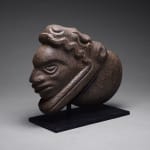Basalt Stone Head, 300 CE - 600 CE
Stone
31.1 x 22.2 cm
12 1/4 x 8 3/4 in
12 1/4 x 8 3/4 in
DJ.1039
Further images
The ball game, perhaps ritually signifying the transit of the sun and moon between the celestial and terrestrial spheres, was an important event in Mesoamerican culture, considered necessary to maintain...
The ball game, perhaps ritually signifying the transit of the sun and moon between the celestial and terrestrial spheres, was an important event in Mesoamerican culture, considered necessary to maintain the cosmic cycle. The game was both a sport and a sacrificial ritual. Made out of heavy stone, the hacha was possibly used as an extra burden of weight to test the physical prowess of the player. In fact, relief sculptures and terracotta figures show axe-shaped objects attached to ball- players’ belts, which were used as deflectors and protectors. The game itself used a large rubber ball that could be hit by the elbows, knees or hips but could not be touched by the hands or feet.
This is one of the later style hachas that were typically flatter than the earlier examples that were larger and rounder. Some scholars believe that the origin of hachas might be traced back to trophy heads. This hacha depicts the head of a man emerging from the open mouth of a serpent. His facial features are characteristically Mayan, including the shape of the nose and eyes. The beauty and intricate carving of this hacha reveals the ceremonial significance of the ball game in the daily lives of Ancient Mesoamericans.
This is one of the later style hachas that were typically flatter than the earlier examples that were larger and rounder. Some scholars believe that the origin of hachas might be traced back to trophy heads. This hacha depicts the head of a man emerging from the open mouth of a serpent. His facial features are characteristically Mayan, including the shape of the nose and eyes. The beauty and intricate carving of this hacha reveals the ceremonial significance of the ball game in the daily lives of Ancient Mesoamericans.





